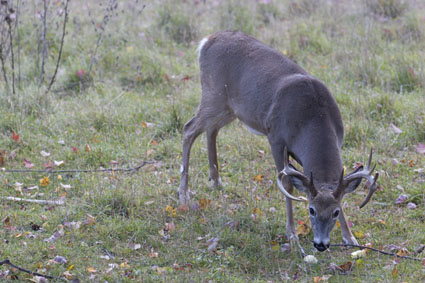 One of the secrets to finding trophy bucks during the late season is to concentrate your efforts in and around food sources. Hunting pressure can be high near obvious areas such as standing corn fields and green alfalfa lots that offer easy access. Eventually excessive human intrusion will cause racked bucks to seek food and cover elsewhere.
One of the secrets to finding trophy bucks during the late season is to concentrate your efforts in and around food sources. Hunting pressure can be high near obvious areas such as standing corn fields and green alfalfa lots that offer easy access. Eventually excessive human intrusion will cause racked bucks to seek food and cover elsewhere.
So where do these bucks go? Another food source! When temperatures plummet scattered apple trees and small abandoned apple orchards can be just the ticket to success. Does will seek out these secret feeding areas for frozen apples, and hard-horned bucks will patrol these trees hoping for a bite to eat and one last encounter with a hot doe.
Locating Apple Trees
Locate single apple trees in the spring by looking for pink-white flowering trees in hedge rows, field edges, grown-over fields, and creek beds. They are easy to spot, even from a distance, with a pair of binoculars.
Or you can study topographical maps for evenly-spaced rows of squiggly green circles, indicating the presence of an orchard. You can also bet there will be a few apple trees growing near abandoned farmsteads. Simply look on your map for unimproved roadways that dead end around a cluster of buildings. There always seems to be an apple tree or two growing nearby.
Nothing however beats shoe leather. As you scout your hunting grounds pay attention to the location of apple trees, and then mark them on your topographical map. Later take a pencil and draw a line connecting the dots. This will be your still-hunting route during the late season.
I like to keep tabs on the apple crop during the summer and early fall. A late spring frost for example can kill the buds and an autumn wind storm can drop all the fruit to the ground where they will quickly be gobbled up. Ideally, apples will fall at intervals all season long, giving you ample time to catch a buck flat-footed in the vicinity.
Strategy
Racked bucks will be looking for does feeding on frozen apples in these remote sites by going from one tree to the next. You do not know when a buck will show up, so erecting a stand over a lone apple tree is a long shot, but still-hunting from one tree to the next, and blind calling with periodic estrous doe bleats and tending grunts, will definitely increase your odds.
If you do not know where the next apple tree might be, simply follow any heavily used trail as the deer, too, will be hoofing it from one tree to the next. Do not walk in the deer trail however. Human scent will linger on snow just as it does on bare ground.
Bowhunting the late season often means dealing with snow. If the snows are deep, you may need to strap on a pair of snowshoes to get into the backcountry. Ash and rawhide snowshoes are often clumsy and difficult to navigate through thick brush and over uneven terrain. Modern snowshoes however with their aluminum frames, waterproof webbing, and ice-gripping crampons do not require constant readjustments and can get you in and out of the woods with surprising ease.






